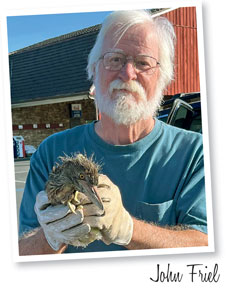5/1/2024
Perennial Potpourri
John Friel

One brisk sunny March day, the Perennial Plant Association’s Regional Symposium in Swarthmore, Pennsylvania, offered a sampler of the mid-Atlantic’s horticultural riches. Takeaways:
Eloise Gayer: A mansion in the old-money Philadelphia Main Line ’burbs is a counterintuitive location for the Natural Lands Trust (NLT). The non-profit NLT mostly focuses on woodlands and wetlands in Pennsylvania and New Jersey. Stoneleigh features European-style formal gardens, designed and expanded for 50 years by the Olmstead brothers.
But under Lead Horticulturist Gayer, a native garden is evolving. They’ve eradicated 2.5 acres of English ivy, so just 5 to go. Old exotic trees can stay, but not beds of Asian Pachysandra. The erstwhile swimming pool area contains bog plantings. Dead trees are “tree sculptures.”
NLT selects plants by “ecoregion,” transcending nativity, considering climate, soils, and flora and fauna that harmonize ecologically. Stoneleigh gardeners sow seed collected at other NLT sites.
The gardens host local artists, schoolchildren, yoga teachers and more. Crews leave the leaves insofar as possible in a public garden. Spring cutback and cleanup wait for three consecutive nights above 50F, allowing overwintering insects to vacate.
Native plant enthusiasts differ on seed-propagated straight species versus cloned varieties selected for particular traits. Eloise’s take? “We love our cultivars at Stoneleigh.”
Edmund Snodgrass: “I live where I grew up,” Ed said. That’s Emory Knoll Farm, which Ed’s family has owned for 180 years. Of 400 original acres, 141 remain. After decades of broadcasting chemicals on corn and soybeans, he said, “I have a debt to pay” to the Earth. After 41 years sans chemical applications? “I live in a garden. A tree with holes in its leaves is a delightful thing.”
Ed literally wrote the book on green roofs: “Green Roof Plants: A Resource and Planting Guide.” He also lectures and consults internationally, most recently in Japan, on biodiversity and “rewilding”—a hot topic, especially in Europe, where back-to-naturists say, “Just step away, let nature heal itself.” But rewilding the humid, fertile mid-Atlantic demands aggressive management of exotics while re-establishing natives. Take a hands-off approach, and multiflora rose, privet, bittersweet and/or Asian honeysuckle will soon smother your project.
Reducing tilled acreage dramatically increases insect and animal species. “A farm is a very sterile place,” Ed said. “Farmlands and suburbia have very low diversity.” Ed grows 60 acres of spring-blooming asclepias and fall-blooming goldenrod, plus “biostrips” of other pollinator-friendly flowers, accommodating insects’ “optimum foraging strategy”: maximum energy gained/minimum energy expended. Pollen-seekers can visit repeatedly and be rewarded.
At a U.S. government site, a 6-acre lawn became a dry “healing” garden, a quiet place where PTSD sufferers find peace. In Ecuador, indigenous species adorn street planters, supporting birds and pollinators. “We know it’s successful because people are stealing the plants. They’re voting with their fingers.”
Dan Benarcik: Designing lush, zone-denying courtyard gardens at Chanticleer, Dan presides over acquisition and inevitable loss of unusual plants. His description of that sometimes-painful process brought back a PPA memory, an oldtimer’s advice: If you have plants nobody else has, share them, widely. They may die for you, or the next guy, but probably not everywhere. You can recover them.
That popped into my head when Dan said, “You may lose that precious thing, but if you shared it, you will certainly get it back.”
Dan’s gorgeous images included favorites like Spigelia marilandica and Euphorbia Ascot Rainbow, but far more unknowns like rhapidiophyllum and phyteuma. His last series was titled “The perennial nature of gratitude,” summed up thusly: “We are nothing more than our networks and relationships in this industry.”
Rychele Stipcak: Rychele studied at Penn State, interned at Chanticleer and worked at Phipps Conservatory. She focused not on plants, but on her journey in horticulture. She urged the audience to “Learn, grow, survive and feel fulfilled,” asking us to “Imagine yourself as a garden” whose different areas have different strengths, weaknesses and needs—and weeds to pull. She spoke glowingly of the plantsmen and women who have nurtured her, urging young listeners to find such mentors and ultimately become one. GP
John Friel is a freelance writer with more than 40 years of experience in horticulture.